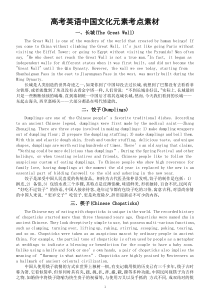 DOC
DOC
【文档说明】高中英语高考复习传统文化考点素材(中国文化元素).doc,共(9)页,133.000 KB,由鹿哥教育上传
转载请保留链接:https://www.ichengzhen.cn/view-233769.html
以下为本文档部分文字说明:
1高考英语中国文化元素考点素材一、长城(TheGreatWall)TheGreatWallisoneofthewondersoftheworldthatcreatedbyhumanbeings!IfyoucometoChinawi
thoutclimbingtheGreatWall,it'sjustlikegoingPariswithoutvisitingtheEiffelTower;orgoingtoEgyptwithoutvisitingthePyramids!Menofte
nsay,"HewhodoestnotreachtheGreatWallisnotatrueman."Infact,itbeganasindependentwallsfordifferentstateswhenitwasfirstbuilt,anddidnotbecomethe"
GreatWall"untiltheQinDynasty.However,thewallweseetoday,startingfromShanhaiguanPassintheeasttoJiayunguanPassinthewest,wasmostlybuiltduringtheMingDyn
asty.长城是人类创造的世界奇迹之一。如果你到了中国却没去过长城,就想到了巴黎没有去看看菲尔铁塔,或者就像到了埃及没有去看金字塔一样。人们常说:“不到长城非好汉。”实际上,长城最初只是一些断断续续的城墙,直到秦朝统一中
国后才将其连城长城。然而,今天我们看到的长城——东起山海关,西至嘉峪关——大部分都是在明代修建的。二、饺子(Dumplings)DumplingsareoneoftheChinesepeople’sfavo
ritetraditionaldishes.AccordingtoanancientChineselegend,dumplingswerefirstmadebythemedicalsaint---ZhangZhongjing.Thereare
threestepsinvolvedinmakingdumplings:1)makedumplingwrappersoutofdumplingflour;2)preparethedumplingstuffing;3)makedumplingsandboilthem.Withth
inandelasticdoughskin,freshandtenderstuffing,delicioustaste,anduniqueshapes,dumplingsarewortheatinghundredsoftimes.Ther
e’sanoldsayingthatclaims,“Nothingcouldbemoredeliciousthandumplings”.DuringtheSpringFestivalandotherholidays,orwhentreatingrelativesandfr
iends,Chinesepeopleliketofollowtheauspiciouscustomofeatingdumplings.ToChinesepeoplewhoshowhighreverenceforfamilylove,havingdumplingsatthemom
enttheoldyearisreplacedbythenewisanessentialpartofbiddingfarewelltotheoldandusheringinthenewyear.饺子是深受中国人民喜爱的传统食品。相传为古代医圣张仲景发明。饺子的制作是
包括:1)擀皮、2)备馅、3)包馅水煮三个步骤。其特点是皮薄馅嫩,味道鲜美,形状独特,百食不厌。民间有“好吃不过饺子”的俗语。中国人接亲待客、逢年过节都有包饺子吃的习俗,寓意吉利。对崇尚亲情的中国人来说,“更岁交子”吃饺子,更是欢度除夕、辞旧迎新必不可少的内容。三、筷子(
ChineseChopsticks)TheChinesewayofeatingwithchopsticksisuniqueintheworld.Therecordedhistoryofchopsticksstartedmorethanthr
eethousandyearsago.ChopstickswerenamedzhuinancientChinese.Theylookdeceptivelysimpletouse,butpossessmulti-variousfunctions,suchasclamping,tur
ningover,liftingup,raking,stirring,scooping,poking,tearing,andsoon.Chopsticksweretakenasanauspiciousmascotbyo
rdinarypeopleinancientChina.Forexample,thepartialtoneofchopsticksisoftenusedbypeopleasametaphoratweddingstoindicat
eablessingorbenedictionforthecoupletohaveababysoon.Unlikeusingaknifeandforkorone’sownhands,apairofchopsticksalsoimpliesthemeaningof“Harmonyiswhat
matters”.ChopsticksarehighlypraisedbyWesternersasahallmarkofancientorientalcivilization.中国人使用筷子就餐的方式在世界上独树一
帜。有史记载用筷的历史已有三千多年。筷子古时称为箸,它看似简单,但却同时具有夹、拨、挑、扒、拌、撮、戳、撕等多种功能。中国民间视筷子为吉祥之物,如婚俗中将筷子隐喻为快生贵子的祝福等。与使用刀叉以及手抓的方式不同,成双结对的筷2子
含有“和为贵“的意蕴。西方人赞誉筷子是古老的东方文明。【拓展1】TheStoryofChopsticks(1)筷子的故事⑴ChopsticksareusedeverydayinChina.⑵NowI'dliketotakethisopportun
itytosharetheirinterestinghistorywithyou.⑶Ithinkyou'llagreethatevenanordinaryitemusedindailylifecanhaveafascinatingstory.⑷Althoughchopst
icksoriginatedinChina,theyarewidelyusedinmanyAsiancountries.⑸Thefirstchopsticksweremadefromboneandjade.⑹IntheSpringan
dAutumnperiod,copperandironchopstickscameintobeing.⑺Inancienttimes,therichusedjadeorgoldchopstickstodisplaytheirwealt
h.⑻Manykingsandemperorsusedsilverchopstickstoseeiftheirfoodhadbeenpoisoned.⑼Chopsticksaretraditionallyplacedinbrides'dowries,be
cause"chopsticks"inChineseispronounced"kuaizi",whichsoundslike"getasonsoon."⑽ManyforeignfriendstrytousechopstickswhentheyvisitChina
.⑾EventheformerpresidentoftheUnitedStatesRichardNixon,usedchopsticksatthewelcomingbanquetheldinhishonor
.⑿Assoonashelefthistable,aforeigndiplomatgrabbedhischopsticksasahistoricalsouvenir.⑴中国人每天都在使用筷子。⑵现在我想借这个机会和大家一起聊一些有关于筷子历史的有趣故事。⑶我想你会赞同即使是日常生活中
一件小物品也会有其引人入胜的故事。⑷虽然筷子起源于中国,但现在很多的亚洲国家都在使用。⑸最早的筷子是用骨头和玉制成的。⑹在春秋时代又出现了铜制和铁制的筷子。⑺在古代,富人家用玉筷子或金筷子以显示其家庭的富有。⑻许多帝王用银制的筷子以检查他们的食
物中是否被人投了毒。⑼筷子在传统上是被当作新娘的嫁妆的,因为“筷子”在汉语中读作“kuaizi”,听起来很像“快得儿子”。⑽许多外国朋友在访问中国的时候都使用筷子。⑾甚至是美国前总统尼克松在为其到来而举办的欢迎宴会上也使用了筷子
。⑿他刚一离开桌子,一名国外的外交人员就抓起了他的筷子,把它作为了具有历史意义的纪念品。【拓展2】TheStoryofChopsticks(2)筷子的故事⑴InancientChina,chopstickssignifiedfarlorethantools
thattakefoodtothemouth;theyalsosignifiedstatusandrules,“can”and”can’t”.⑵DuringtheNorthernSongDynasty,anofficialnamedTangSuoncehaddinnerwit
htheemperor.Hewasnotwellinformedinnobletableetiquetteandsolaiddownhischopstickshorizontallyonthetableb
eforetheemperordid.Asaresult,hewasexpatriatedtoafrontierareaforpenalservitude.⑶Inancienteatingetiquette,therewereoveradozentaboosconceningchop
sticks.Forexample,theycouldnotbeplacedverticallyintoadish,asthiswasthewayofmakingsacrificestothedead.⑴在古代中国,筷子不仅仅是把食物送到口中的餐具,它被赋予了重要的内
涵和“能”和“不能”的规矩。⑵北宋朝时,一个叫唐肃的官员陪皇帝进膳。他不了解用餐时使用筷子的礼仪,在皇帝还没有吃完时,他把筷子横放在桌子上,表示他不想再吃了。结果这位官员被发配边疆。3⑶在古代的饮食礼仪中,筷子的使用方法
的禁忌有十多种。比如,忌将筷子竖直插入菜盘或饭碗中,因为这代表为死人上坟。四、中国功夫(Chinesekungfu)Chinesekungfu,orChinesemartialarts,carriestraditionalChinesec
ultureinabundance.ItisatraditionalChinesesportwhichappliestheartofattackanddefenceincombatandthemotionsengagedwithaseriesofskillandtr
icks.ThecoreideaofChinesekingfuisderivedfromtheConfuciantheoryofboth“themeanandharmony”and“cultivatingqi”(otherwiseknownasnourishingone’
sspirit).Meanwhile,italsoincludesthoughtsofTaoismandBuddhism.Chinesekungfuhasalonghistory,withmulti-variouss
ectsandmanydifferentboxingstyles,andemphasizescouplinghardnesswithsoftnessandinternalandexternaltraining.Itcontainstheanc
ientgreatthinkers’ponderingoflifeandtheuniverse.Theskillsinwieldingthe18kindsofweaponsnamedbythelatergenerationsmainlyinvolvetheskills
ofbare-handedboxing,suchasshadowboxing(Taijiquan),formandwillboxing(Xingyiquan),eighttrigrampalm(Baguazhang),andtheskillsofk
ungfuweaponry,suchastheskillofusingswords,spears,two-edgedswordsandhalberds,axes,tomahawks,kooks,prongsan
dsoon.中国功夫即中国武术,是将技击寓于搏斗和套路运动之中的中国传统体育项目,承载着丰富的中国民族传统文化。其核心思想是儒家的中和养气之说,同时兼容了道家、释家的思想。中国武术源远流长、流派林立、拳种繁多,讲究刚柔并济、内外兼修,蕴含着先哲们对生命和宇宙的参悟。后世所称
十八般武艺,主要指:徒手拳艺,如太极拳、形意拳、八卦掌等;器械功夫,如刀枪剑戟、斧钺钩叉等。【拓展】⑴ChineseKungFuismagnificentandprofoundbutit’sunfortunatethataloto
fithasnotbeenpasseddown.⑵Taijiquancanmakeyoufeelatpeace.Inadditiontoemphasizingmatchingthemovementswithyourbreathing,itisgoodforyourhealthtoo.⑶
Theprimaryreasonforpracticingkungfuisforhealthreasons.Defenseisofsecondaryimportanceandhurtingothersisabolutelyunacceptable.⑴中国功夫博
大精深,可惜有很多已经失传了。⑵太极拳可以使人心境平和,加上它注重呼吸配合动作,对身体也有好处。⑶练武的主要目的在于锻炼身体,其次是防身,至于用来伤人是万万不可以的。ThereismuchmoretoKungFuthanJackieChanorBruce
Lee.KungFuisanartform,andalso,verygoodforyou.功夫并不只是指成龙或李小龙,它是一种艺术形式,而且对你很有好处。ManystylesofKungFuarebasedontheide
asofnature.Ancientboxingmastersoftendevelopedtheirfightingtechniquesbyobservingtheworldaroundthem.Animals,birds,andinsectsprovidedthebasisformanysys
temsofKungFudevelopedinthepast.很多功夫招式来源于对自然界的想象。古代拳术大师常常通过观察他们周围的世界改进拳术技法。动物、鸟类和昆虫为过去很多功夫的系统发展提供了基础。Manyofthehardforms
ofKungFucamefromaBuddhistMonasterycalled“Shaolin”.AnIndianpriestnamedTamocametolivetherenearly1500yearsagou.Acco
rdingtolegend,Tamoarrivedatthemonasterywherehefoundthemonksinpoorphysicalcondition.Becausetheycouldn’tstayawakeduringmeditation,Tamointroduc
edaseriesof18exercisedesignedtofeedbothbodyandmind.Thesemovementsaresaidtohavemergedwithself-defensetacticsstudiedintheShaolinTem
ple.很多硬功夫都出自叫“少林”的佛教寺庙。大约1500年前,有个叫达摩的印度僧人来到这里。传说他来到寺庙,发现那里的和尚身体状况很不好。因为他们在坐禅时候不能保持清醒,达摩就传4授给他们一套十八手拳法,目的是锻炼他们的身心。据
说这些动作融合了他在少林寺研究的防身术。IsuggestasoftformofKungFu,calledTaiQi.ItcomesfromTaoismandit’sverygoodforyourhealth.Throughitstraining
,youcangetinnerpeaceandasenseofphysicalandemotionalwellbeing.It’softencalledChineseYoga:theartandscienceofmedita
tionthroughmovement.我建议你学习一种温和的功夫,叫太极拳。它源于道教,对你的健康非常有好处。通过这种训练,你能达到内心的平和,以及身体和情绪上的安宁舒适。它经常被人们称作中国瑜伽:通过运动达到沉思冥想的一种艺术和科学。五、汉字(Chinesecharacters)Chinese
characterswereinitiallymeanttobesimplepicturesusedtohelppeoplerememberthings.Afteralongperiodofdevelopme
nt,itfinallybecameauniquecharactersystemthatembodiesphoneticsound,image,idea,andrhymeatthesametime.Thewritingsystem,whichwasextremelyadvancedinanc
ienttimes,beganwithinscriptionsonbonesandtortoiseshells,andtheseareregardedastheoriginalformsofChine
secharacters.Afterwards,Chinesecharacterswentthroughnumerouscalligraphicstyles:bronzeinscriptions,officialscript,regularscript,cursivescript,
runningscript,etc.Chinesecharactersareusuallyroundoutsideandsquareinside,whichisrootedinancientChinesebeliefsofanorbicularskyandarect
angularEarth.ThefivebasicstrokesofChinesecharactersare“---“(thehorizontalstroke)“│”(theverticalstroke),“/”(theleft-fallingstrok
e),“\”(theright-fallingstroke),and“乙”(theturningstroke).汉字是从原始人用以记事的简单图画,经过不断演变发展最终成为一种兼具音、形、意韵的独特文字。现存中国古代最早成熟的文字是甲骨文,被认为是现代汉字的初形。此后,汉字又经历了金文、隶书、楷书
、草书、行书等不同的阶段。汉字结构“外圆内方“,源于古人”天圆地方“的观念。汉字有五种基本笔画,即:横、竖、撇、捺、折。六、秧歌舞(Yangko)YangkoisoneoftraditionfolkdanceofHaninChina.It
isusuallyperformedinnorthernprovinces.Thedancersusuallywearcolorfulandlightcostumes,andtheperformanceispowerfulandrapid.DuringsomefestivalssuchasSpri
ngFestival,LanteinFestival,ifpeoplehearthesoundofdrumandgong,nomatterhowcoldtheweatheris,theywillcometostreetan
dappreciatetheYangko.Recentyears,theoldpeopleincityofeast-northernofChinaorganizedtheteamofYangkobythemselves,theteamerskeep
theirhealthbydancingYangkothewholeyear.秧歌舞是中国汉族的一种民间传统舞蹈,通常在北方省份表演。秧歌舞者通常穿上明亮多彩的表演服装,他们的表演动作有力迅速。在农历春节、元宵节等节日期间,人们一旦听到锣鼓声,不管
外面天气有多冷,他们都会蜂拥到街上看秧歌舞表演。近年来,中国东北某些城市的老年人自发组织了了秧歌队,队员常年通过跳秧歌舞来保持健康,同事他们也乐在其中。七、针灸(Acupuncture)AcupunctureisanimportantpartoftraditionalChinesemedicine
(TCM).Inaccordancewiththe“mainandcollateralchannels”theoryinTCM,thepurposeofacupunctureistodredgethechannelandregulateqiandblood,soastokeepthebod
y’syinandyangbalancedandachievereconciliationbetweentheinternalorgans.ItfeaturesintraditionalChinesemedicinethat“int
ernaldiseasesaretobetreatedwithexternaltherapy”.Themaintherapyofacupunctureinvolvesusingneedlestopierc
ecertain5acupointsofthepatient’sbody,oradoptingmoxibustiontostimulatethepatient’sacupointssoastostimulatethechannelsandrelievepain.Withitsuni
queadvantages,acupuncturehasbeenhandeddowngenerationaftergenerationandhasnowspreadallovertheworld.Nowadays,acupunct
ure,alongwithChinesefood,kungfu(otherwiseknownasChinesemartialarts),andtraditionalChinesemedicine,hasbeeninternationallyhaile
dasoneofthe“fournewnationaltreasures.”针灸是中医学的重要组成部分。按照中医的经络理论,针灸疗法主要是通过疏通经络、调和气血,来达到阴阳归于平衡,使脏腑趋于调和之目的。其特点是“内病外治”。主要疗法是用针刺入病人身体的一定穴位,或用艾火的温热刺激烧灼
病人的穴位,以达到刺激经络。治疗病痛的目的。针灸以其独特的优势,流传至今并传播到了世界,与中餐、功夫、中药一起被海外誉为中国的“新四大国粹”。八、中国龙(ChineseDragon)DragontotemworshipinChi
nahasbeenaroundforthelast8,000years.TheancientsinChinaconsideredthedragon(orloong)afetishthatcombinesanimalsi
ncludingthefish,snake,horseandoxwithcloud,thunder,lightningandothernaturalcelestialphenomena.TheChinesedragonwasfor
medinaccordancewiththemulticulturalfusionprocessoftheChinesenation.TotheChinese,thedragonsignifiesinnovationandcohesion.对龙图腾他的崇拜在中国大约已绵延了八千多
年。中国龙是古人将鱼、蛇、马、牛等动物与云雾、雷电等自然天象集合而成的一种神物。中国龙的形成与中华民族的多元融合过程同步。在中国人的心目中,龙具有振奋腾飞、开拓变化的寓意和团结凝聚的精神。九、中国印章(ChineseSeal)Asealcana
lsobedefinedasastamp.BoththeChineseofficialandprivatesealofvariousdynastieshavedifferenttitles,suchasstamp,zhunote,contract,fu,lea
seandothers.ThesealsusedbytheemperorsofancientChinawerecalledxi,yin,bao,etc.Accordingtohistoricalrecords,sea
lswerewidelyusedduringtheWarringStatesPeriod(475BC-221BC).Themakingofasealistoengravefonts,suchassealcharactersandofficialscriptandsoon;orimag
esintheformofintaglioandembossmentintotheseal,basicallyshapedasroundorsquare.Coveredwithavermilionoverlay,theChineseseali
snotonlyusedindailylife,butitisalsousedtorepresentsignaturesonpaintingsandcalligraphies.Itisgraduallybecom
ingoneofChina’suniqueartworks.印章就是图章。中国历代官、私所用的印章有印信、朱记、合同、符、契等等不同的称谓,而帝王所用的印章古时称玺、印、宝、章等。据史料记载,印章在战国时代已普
遍使用。印章的制作是将篆隶等字体、图像用阴、阳的形式雕刻而成,形状以圆、方为主。印章用朱色钤盖,除日常应用外,又多用于书画题识,逐渐成为中国特有的艺术形式之一。十、京剧(ChineseBeijingOpera)Praisedas“OrientalOpe
ra”,BeijingOperaisagenuinenationalquintessenceofChina.Itoriginatedfrommanykindsofancientlocaloperas,especiallyhuiban
insouthernChina.Attheendofthe19thCentury,BeijingOperaevolvedandtookshape,becomingthegreatestkindofoperainChina.Beijing
Operaisablendofperformingarts---song,speech,performance,acrobatixfightinganddance.BeijingOperaportraysandnarratestheplotandcha
ractersthroughstylizedacting.ThemaintypesofrolesinBeijingOperaaresheng(male),dan(youngfemale),jing(paintedface,
male),andchou(clown,maleorfemale).京剧被誉为“东方歌剧”,是地道的中国国粹。它起源于中国多种古老的地方戏剧,特别是南6方的“徽班”。到了19世纪末,京剧形成并成为中国最大的戏曲剧种。京剧是综合性表演艺术,集唱(歌
唱)、念(念白)、做(表演)、打(武)、舞(舞蹈)为一体,通过程式化的表演手段,叙述故事,刻画人物。角色主要分生(男性)、旦(女性)、净(男性)、丑(男性女性皆有)四大行当。【拓展】BeijingOpera京剧⑴BeijingOperaofChinaisanational
treasurewithahistoryof200years.⑵Facialmasksareanimportantwaytoportrayacharacter.⑶Eachrole,accordingtotheirs
ex,ageanddisposition,ischaracterizedbydifferentdesignsoffacialmake-up(facialmask).⑷InPekingOpera,femalrolesare“Dan”.Male
rolesare“Sheng”.Andclownsare”Chou”.⑸Present-daydesignersarealsoborrowingfromtheBeijingOperafortheirwork.⑴京剧是
中国的国粹,迄今已经有200多年的历史。⑵脸谱是塑造人物形象的重要手段。⑶每个角色都会按照他们的性格、年龄、个性,在脸上画不同的脸谱。⑷在京剧中,女性的角色被称作“旦”,男性的角色被称作“生”,小丑被称作“丑”。⑸当代服装设计师也从京剧服装中吸取灵感。十一、中国成语(ChineseIdio
ms)Chineseidiomsrefertocomprehensiveandintegratedfixedphrasesandexpressions.Idiomsareestablishedandacce
ptedbyconstantusageandcommonpractice.Anidiomisalanguageunitthatislargerthanaword,buthasthesamegrammaticalfunctionasaword.MostChineseidiomsconsist
offourcharacters.Forexample,ziqiangbuxi(makeunremittingeffortstoimproveoneself),qingchuyulan(bluerthanindigo),andhoujibofa(
successcomeswithtimeandeffort).Idiomsareextratedfromfolkproverbs,ancientworksofliterature,poems,fables,allusions,andwell-knownsayings.Idio
msareapartoftheChineselanguagethatareconciseandhavegreatvitality.中国成语是汉语中意义完整的表示一般概念的固定词组或短语。“成语”中的“成”既是约定俗成。成语是比词大而语法功能又
相当于词的语言单位。绝大多数的中国成语由四个汉字组成,例如:自强不息、青出于蓝、厚积薄发。成语主要从民间谚语、古代文学作品、诗歌、寓言、典故、名言警句等方面提炼而成,是汉语语言中精炼而又富有生命力的一部分。十二、丝绸(Silk)Chinaisthehomeofsilk.Mulberryplan
ting,sericulture,silkreelingandthickeningareallgreatinventionsoftheancientChinese.AsearlyastheShangandZhouDynasties(1600BC-2
56BC),theChinesepeople’ssilk-weavingtechniqueshadreachedanextremelyhighlevel.DuringtheWesternHanDynasty(206BC-25AD),ZhangQian,anou
tstandingdiplomat,travelledaroundcentralAsiaandconnectedChinawiththePersianGulfandtheMediterranean,openingupaneweraofSino-foreignt
rade,exchangeandcommunication.Fromthenon,China’ssilkbecamewellknownforitsextraordinaryquality,exquisitedesignandcolor,andabundantcultureconnotations
.Hitherto,ChinesesilkhasbeenacceptedasasymbolofChinesecultureandtheemissaryoforientalcivilization.中国是丝绸的故乡。栽桑、养
蚕、缫丝、织绸是中国古代人民的伟大发明。商周时期丝绸的生产技术就已发展到相当高的水平。西汉时张骞通西域,把中原与波斯湾、地中海紧密联系起来,开辟了中外交流贸易的新纪元。从此中国的丝绸以其卓越的品质、精美的花色和丰富的文化内涵闻名于世,成为中国文化的象征。东方文明的使者。十三、中国园林Chinese
ClassicalGardenTheChineseclassicalgardenisaprecioustreasureofourancientChinese7architecture.Itisakindofenvironmentart,whichsystematicallycombinesa
rtificialmountainsandrivers,plantsandbuildingswiththenaturallandscape.TheconstructionstandardofaChineseclassicalg
ardenis“artificialasitis,thegardenmustlookingeniousandnatural.”WhenyougosightseeinginaChineseclassicalgarden,youshouldbeablet
oappreciateitsartisticconceptwhich“makesuseofthenaturallandscapetocreatetherealfunofmountainsandrivers
forviewers.”Oftheworld’sthreemajorgardensystems,theChineseclassicalgardenishailedasoneoftheoriginsoftheworld’sgardenduetoitslonghis
toryandabundantconnotations.中国园林是把人造的山水、植物、建筑等与自然地貌有机结合的环境艺术,是我国古代建筑艺术的珍宝。其建造原则是“妙极自然,宛自天开”。游赏中国古典园林,能充分领略“假自然之景,创山水真趣”的园林意境。在世界三大园林
体系中,中国园林历史悠久、内涵丰富,被誉为世界造园史上的渊源之一。十四、文房四宝(TheFourTreasuresoftheStudy)Thewritingbrush,inkstick,inkstone,andpaperwererequisitetreasuresinthes
tudyofthescholarsofancientChina,andtheyareoftenreferredtoasthe“FourTreasuresoftheStudy.”ThewritingbrushandinkstickhavebeenusedbytheChineseto
writeandpaintsince5,000yearsago.IntheQinDynasty(221BC---206BC),peoplealreadyusedfeathersofdifferenthardnessandbambootrunkst
omakebrushes.DuringtheHanDynasty(206BC-220AD),man-madeinkwasusedinsteadofnaturalink.AfterpaperwasinventedbytheChinese,bamboosl
ips,woodentablets,brocadeandsilk,whichoriginallyfunctionedaswritingsurfaces,graduallyfadedout.Theinkstonewasfirstdeveloped
withtheuseofwritingbrushesandink.AftertheSongDynasty(960AD---1279AD),the“FourTreasureoftheStudy”particularlyreferredtohubi,thewritingb
rushproducedinHuzhou,Zhejiangprovince;huimo,theinkstickproducedinHuizhou,Anhuiprovince;xuanpaper,akindofpaperproducedinXuanzhou,Anhuiprovince;anddu
anyan,theinkstonemadeinZhaoqing,Guangdongprovince(ZhaoqingwasearliercalledDuanzhou).Indeed,theFourTreasuresoftheSt
udy”havewrittinthewholeChinesecivilization,asitis.笔墨纸砚是中国古代文人书房当中必备的宝贝,被称为“文房四宝”。用笔墨书写绘画在中国可追溯到五千年前。秦时已用不同硬度的毛和竹管制笔;汉代以人工制墨替代了天然墨;有了纸张以后,简牍锦帛逐失其用;砚
台则随笔墨的使用而发展。“文房四宝”到宋朝以后特指湖笔、徽墨、宣纸、端砚。可以说文房四宝书写了整个中华文明。十五、中国印章(ChineseSeal)Asealcanalsobedefinedasastamp.BoththeChineseofficialandprivatesealofva
riousdynastieshavedifferenttitles,suchasstamp,zhunote,contract,fu,leaseandothers.ThesealsusedbytheemperorsofancientChinawerecalledxi,
yin,bao,etc.Accordingtohistoricalrecords,sealswerewidelyusedduringtheWarringStatesPeriod(475BC-221BC).Themakingofasealistoengravefonts
,suchassealcharactersandofficialscriptandsoon;orimagesintheformofintaglioandembossmentintotheseal,basicallyshape
dasroundorsquare.Coveredwithavermilionoverlay,theChinesesealisnotonlyusedindailylife,butitisalsousedtorepresentsign
aturesonpaintingsandcalligraphies.ItisgraduallybecomingoneofChina’suniqueartworks.印章就是图章。中国历代官、私所用的印章有印信、朱记、
合同、符、契等等不同的称谓,而帝王所用的印章古时称玺、印、宝、章等。据史料记载,印章在战国时代已普遍使用。印章的制作是将篆隶等字体、图像用阴、阳的形式雕刻而成,形状以圆、方为主。印章用朱色钤盖,除日常应用外,又多用于书画题识,逐渐成为中国特有的艺术形式之一。8十六、天干地支(Ch
ineseEra)TheChineseeraisthesymbolthattheChinesecalendarusesforrecordingandnamingyears.ThetenHeavenlyStemsare:
jia,yi,bing,ding,wu,ji,geng,xin,ren,gui.ThetwelveEarthlyBranchesare:zi.chou,yin,mou,chen,si,wu,wei,shen,you,xu,hai.Afterobservingthelunarm
onth,theancientsfoundthatthemoonalwayswazesandwanesroughly12timesayear,andtwolunarmonthsaccountforabout60days,sotheorderofthetenHeavenlySte
msandtheorderofthetwelveEarthlyBranchesareproperlymatchedinturn.Intermsofrecordingdate,60yearsisconsideredtobeafulltim
ecycle.TheChineseerachronologywasfirstinventedinancienttimesandisstillinusenow.天干地支是中国历法中用以记录和命名年岁的方法。十天干为:甲、乙、丙、丁、戊、已、庚、辛、壬、癸;十二地支为
:子、丑、寅、卯、辰、巳、午、未、申、酉、戊、亥。古人观测朔望月,发现月亮圆缺12次大体上是一年的天数,而两个朔望月约是60天。古人以十天干与十二地支的顺序依次相配,记录不同年份,60年为一个轮回。干支纪
年法从古沿用至今。十七、中国画(TheChinesepaitings)⑴It’sinterestingthatChinesepaintingscanbecreatedonthespot.⑵TheChinesedopaintingswithbrushes,dippingt
heirbrushesininkorpaintandthenskillfullywieldingthem.⑶Paintersproduceonthepaperpictureswithlinesanddots——som
eheavy,andsomelight,andsomedeep,andsomepale.⑴真有意思:中国画是可以现场表演的。⑵中国人绘画采用毛笔蘸墨汁或颜色,灵巧的挥洒在纸上。⑶画家用深、浅、浓、淡的点和线构成一幅图画。十八、中西医(Chines
eMedicine)⑴UsuallyaChinesemedicinepractitionerapproachestheillnessfromabroaderperspective,emphasizingitsentiretyanddialecticalimplications.
⑵AWesterndoctordealsdirectlywithsymptoms.Forinstance,ifsomeonehasasorethroat,aWesterndoctorwilltreatitasathroatproble
m,whileaChinesedoctormaylinkittothedisorderofthepatient’sstomach.⑶AChinesedoctorexamineshispatientbyusingmethodlikeobservin
g,smelling,askingandfeeling.HisWesterncounterpartreliesonsymtomsorevidencelikebodytemperatureandlabtests.⑷Forpeoplewithterminaldiseases,Chinesem
edicinemaybetheirlastresort.Chinesemedicinecannotonlyalleviatepain,butalsoofferstheoptionofadifferenttreatment.⑴中医通常从宏
观角度认识问题,强调整体性和辩证施治。⑵西医则从微观入手。比如一个人咽喉痛,西医诊断为咽炎,中医则有可能判断为脾胃失衡的症状。⑶中医通过望闻问切来诊病;西医注重症状,重证据。⑷对于那些身患绝症的人来说,中医也许是他们最后的希望,它可以缓解病痛,为患者提供另一种治疗方案。
十九、书法艺术(TheArtofCalligraphy)⑴Over2000yearsago,EmperorQinShihuang,thefirstEmperorinChinesehistory,establishedtheofficialChinesewritingcharac
ters.⑵Calligraphyalsohaditspracticalvaluesbecauseitwasagoodwaytomakefriends9andwasmorepresentableasa
giftratherthanjewelryormoney.⑶Manypeoplepracticecalligraphyasawaytoraisetheircultureaccomplishment.Olderpeopleusecalligraphywritingas
amethodtokeepfit.⑷IhadthoughtcomputerswouldleadtothedisappearanceofChinesecalligraphy.NowIunderstandthat’snotlikelyto
happen.Howcanyougiveyourbosscomputer-printedcalligraphyasagift.⑸ThebrushisthetraditionalChinesewritingtool.Itstipismadeofsofthairfromasheep,
weaselorrabbit.⑴两千多年前,中国的第一个皇帝秦始皇统一了中国的文字。⑵书法还有着实际的效用,比如结交朋友。比起珠宝或金钱,送人一幅书法作品就来得高雅、体面。⑶很多人研习书法的目的是提升文化素养,老年人学习书法是为了保健
强身。⑷我一直认为电脑的出现会导致中国书法的衰落。现在看来,这不太可能。你怎么能拿着一幅从电脑中打印出来的书法作品送给上司呢?⑸毛笔是中国的传统书写工具。笔尖由羊毛、黄鼬毛或兔毛制成。毛笔的毫毛既软又有弹性。二十、放风筝(Kite-flying)⑴
Kite-flyinghasbeenanoldChinesepastime.⑵Recordsabouttheactivitywerementionedasback2,500yearsago.⑶Overth
ecenturies,peoplehavedevelopedkitesknownfortheirbeauty.⑷Peopleareabletomakethemlooklikeswallows,geese,frogs,
butterflies,peacocks,crabsandmanyotheranimals.⑸Nowpeoplewillflykitesinearlyspringandautumn.⑹It’sreally
averybeautifulscenewithkitesflyinginthesky.⑴放风筝是中国一项古老的娱乐活动。⑵2500年前,就有放风筝的记载。⑶几个世纪以来,风筝因为它的样式美观而众所周知。⑷人们把它做成诸多动物的形状,比如燕子、鹅、青蛙、蝴蝶、孔雀、螃蟹等。⑸现在人们在
初春和初秋放风筝。⑹天空中飞着风筝,真实非常漂亮的景观啊!
 辽公网安备 21102102000191号
辽公网安备 21102102000191号
 营业执照
营业执照